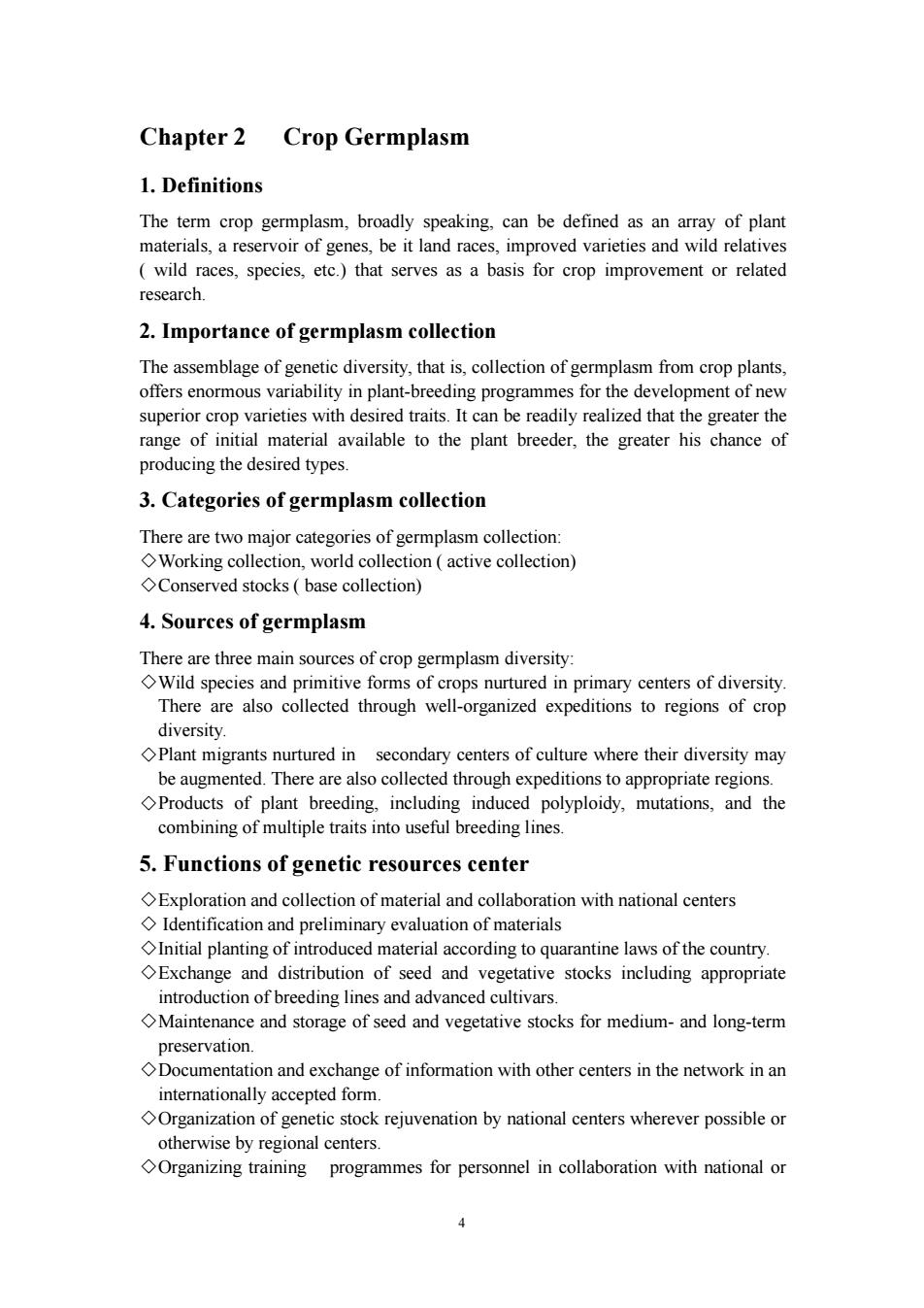正在加载图片...

Chapter 2 Crop Germplasm 1.Definitions The term crop germplasm,broadly speaking,can be defined as an array of plant materials,a reservoir of genes,be it land races,improved varieties and wild relatives (wild races,species,ete.)that serves as a basis for crop improvement or related research. 2.Importance of germplasm collection The assemblage of genetic diversity,that is,collection of germplasm from crop plants, offers enormous variability in plant-breeding programmes for the development of new superior crop varieties with desired traits.It can be readily realized that the greater the range of initial material available to the plant breeder,the greater his chance of producing the desired types. 3.Categories of germplasm collection There are two major categories of germplasm collection: Working collection,world collection active collection) Conserved stocks base collection) 4.Sources of germplasm There are three main sources of crop germplasm diversity: Wild species and primitive forms of crops nurtured in primary centers of diversity. There are also collected through well-organized expeditions to regions of crop diversity. Plant migrants nurtured in secondary centers of culture where their diversity may be augmented.There are also collected through expeditions to appropriate regions. Products of plant breeding,including induced polyploidy,mutations,and the combining of multiple traits into useful breeding lines. 5.Functions of genetic resources center Exploration and collection of material and collaboration with national centers Identification and preliminary evaluation of materials Initial planting of introduced material according to quarantine laws of the country. Exchange and distribution of seed and vegetative stocks including appropriate introduction of breeding lines and advanced cultivars. Maintenance and storage of seed and vegetative stocks for medium-and long-term preservation. Documentation and exchange of information with other centers in the network in an internationally accepted form. Organization of genetic stock rejuvenation by national centers wherever possible or otherwise by regional centers. Organizing training programmes for personnel in collaboration with national or4 Chapter 2 Crop Germplasm 1. Definitions The term crop germplasm, broadly speaking, can be defined as an array of plant materials, a reservoir of genes, be it land races, improved varieties and wild relatives ( wild races, species, etc.) that serves as a basis for crop improvement or related research. 2. Importance of germplasm collection The assemblage of genetic diversity, that is, collection of germplasm from crop plants, offers enormous variability in plant-breeding programmes for the development of new superior crop varieties with desired traits. It can be readily realized that the greater the range of initial material available to the plant breeder, the greater his chance of producing the desired types. 3. Categories of germplasm collection There are two major categories of germplasm collection: ◇Working collection, world collection ( active collection) ◇Conserved stocks ( base collection) 4. Sources of germplasm There are three main sources of crop germplasm diversity: ◇Wild species and primitive forms of crops nurtured in primary centers of diversity. There are also collected through well-organized expeditions to regions of crop diversity. ◇Plant migrants nurtured in secondary centers of culture where their diversity may be augmented. There are also collected through expeditions to appropriate regions. ◇Products of plant breeding, including induced polyploidy, mutations, and the combining of multiple traits into useful breeding lines. 5. Functions of genetic resources center ◇Exploration and collection of material and collaboration with national centers ◇ Identification and preliminary evaluation of materials ◇Initial planting of introduced material according to quarantine laws of the country. ◇Exchange and distribution of seed and vegetative stocks including appropriate introduction of breeding lines and advanced cultivars. ◇Maintenance and storage of seed and vegetative stocks for medium- and long-term preservation. ◇Documentation and exchange of information with other centers in the network in an internationally accepted form. ◇Organization of genetic stock rejuvenation by national centers wherever possible or otherwise by regional centers. ◇Organizing training programmes for personnel in collaboration with national or